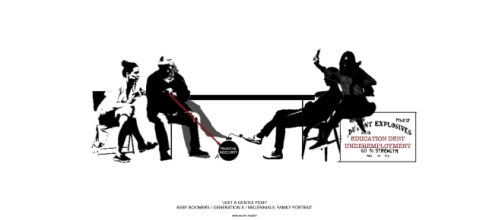The generation gap is not just age based - it's financial. Already labeled 'selfie-centered' and 'over-indulged' by our seniors, statistics are pulling into evidence that we face the reality of being the poorest generation yet.
Arguably the most educated generation, we are not reaping the benefits of academia. With university debt having put most of us into a financial black hole, we are already at a more disadvantaged position than our twenty-something counterparts were thirty to forty years ago. We are in a quagmire – we go into debt to get a salary – a salary which is not sufficient to get us out of the same debt in under a decade.
There is real meat behind the crisis our generation faces. A larger macro-economic perspective sets ablaze the stereotypes that our seniors have cemented us into.
Accounting for our ills is the rising cost in rent, living and essential services. Sandwiched between this is our inheritance: the continuing aftershock of the 2008 recession. An absurdly competitive job market, the compounded effects of climate change, inflation and financial crises are also some of the black sheep that generation x has let wander into our field. Not to mention the challenging political climate. Speculations of a college-debt bubble, much like the tech-bubble caused by the boomers in 1990, are also seeping to the surface.
But let’s not tempt omens of the near future.
Let’s look at what’s happening now.
The Boomers Are Still Booming
According to the Luxembourg Income Study, Millennials are earning 19% less than the national average. To make it through, a large tier of us are working under degree qualifications merely to attain some form of financial security. For those of us lucky enough to have jobs in our field of interest, we are still earning 20% less than our parents were in their twenties. Rising prices in services, lifestyle, childcare and rent result in a lower net wage for millennials. In sum, we have less disposable income than our seniors did at our age. So much so, that the net worth of an average 60 year old is double what it was in 1983.
But a 30 year old in 2013 is worth 21% less than in 1983. The disposable income per head in households has risen 62-66% respectively for 65-69, and 70-74 year olds – the boomers – for the youth it stagnates at a shabby -2%.
What does this mean? The purchasing power and social welfare of the elderly is increasing, while the prospective working and childbearing generation (us, millennials) are knocked out as participants within the consumer and real estate markets. Forget mortgage. Will we be able to save enough for retirement?
The Population ‘Shroom
This economic reality is incompatible with the colloquial description of our population graph: the mushroom. A decreased population of youth supports a larger population of elderly.
With the elderly more financially powerful than the base structure supporting them – the millennials – the mushroom will be weak. More, with raising childcare costs mentioned above, it’s also going to affect how many children our generation raises, and how well we are able to raise them. These hardships are not a punishment for laziness. Stringer observes that in New York City, while worker productivity is up 37.6% but median real wage has only risen by 9.6%. This is a problem. We are more willing to work, more educated than our predecessors, and we are still being paid less?
In fact, the problem faced by millennials as we enter young adulthood is at its most aggressive peak since it began in the 1980s. As millennials, it does not seem we are destined to be millionaires – but a consciousness of our predicament can bring us closer to change.

